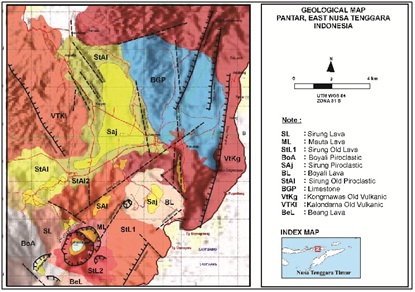Resistivity Models of Pantar Island Geothermal System East Nusa Tenggara, Indonesia
DOI:
https://doi.org/10.25299/jgeet.2020.5.3.5115Keywords:
Magnetotellurics, resistivity models, geothermal systemAbstract
The subsurface geological conditions of a geothermal system are vital objects to be considered in geothermal exploration. The Magnetotellurics survey was conducted to explore for geothermal potential in Pantar Island. This is to achieve deeper penetration compared to our previous study that adopted resistivity method to determine reservoir zones based on rock resistivity models. The difference in rock resistivity in geothermal systems provides subsurface geological information in the form of low resistivity that associated the clay cap zones (high conductive), the medium resistivity zones associated with the reservoir zones, and high resistivity associated with a heat source. The results of 2D and 3D models from MT data show that the low resistivity value (<20Ωm) as a clay cover zones, this layer from the surface to -1000 meters. Medium resistivity values (20-100 Ωm) starting from depths -1000 meters to -2000 meters associated with reservoirs zones, high resistivity values (> 200 Ωm) starting from depths of -2000 meters are considered as heat source from the Pantar geothermal system.
Downloads
References
Aboud, E., Saud, R., Asch, T., Aldamegh., K.,Mogren, S., 2014. Water Exploration using Magnetotelluric and Gravity Data Analysis; Wadi Nisah, Riyadh, Saudi Arabia. National Research Institute of Astronomy and Geophysics Journal 3, 184–191.
Bera, P., X Rao., C.K., 2012. Magnetotelluric Method: A Tool for Deep Crustal Study, 9th Biennial International Conference & Exposition on Petroleum Geophysics, Mumbai: Society of Petroleum Geophysicists India.
Carlson, D.H andPlumer, C..C., 2019. Physical Geology, 16th Edition, Mc Graw Hill. New York,
Hadi, M.N., Kusnadi, D., 2015. Geological and Geochemical Survey, Pantar Geothermal Area, East Nusa Tenggara. PSDG, Bandung, Indonesia. (Text in Indonesian).
Lanfang, He., Chen, L., Dorji, X., Xi, X., Zhao., Chen, R., and Yao, H., 2016.Mapping the Geothermal System using AMT and MT in The Mapamyum (QP) field, Lake of Manasarovar, Southwestern Tibet. Energies Journal.
Lowrie., W., 2012. Fundamentals of Geophysics, Second Edition. Cambridge University Press.
Mary, RT., Armawi, A.,Hadna, A.H., Pitoyo, A.J., 2017. Geothermal is Treasures For Towards Energy Security. Journal Ketahanan Nasional. Indonesia23, 217-237. (Text in Indonesian)
Maryanto, S., Dewi, C.N., Syahra, V., Rachmansyah, A., Foster, J.H., Nadhir. A., Santoso, D.R., 2017. Magnetotelluric Geochemistry Investigations of Blawan Geothermal Field, East Java, Indonesia.
Meju, A.M., 1994. Geophysical Data Analysis : Understanding Inverse Problem Theory and Practice. Society of Exploration Geophysicists (SEG).
Ministry of Energy and Minerals Resources. Indonesia Geothermal Potential.,2017. First Edition.
Moeck. I.S., 2014. Catalog of Geothermal Play Types Based on Geologic Controls. Renewable and Sustainable Energy Reviews 37, 867–882.
Naidu, G.D., 2012. Deep Crustal Structure of The Son-Narmada-Tapti Lineament, Central India. Springer, 13-35.
Nainggolan, S.S., Sastranegara, R.M.T., Raharjo, I.B., 2015. Volcanic Neck of Mount Iyang Argopuro Revealed from Gravity Study. Proceedings WorldGeothermal Congress, 19-25 April 2015, Melbourne, Australia.
Panjaitan, S., 2010.Geology of Ulubelu Tanggamus Geothermal Area, NorthLampung Based on Magnetotelluric (MT) Method Analysis. Jurnal Geologi dan Sumberdaya Mineral, Vol. 20, No. 2 Badan Geologi. Indonesia 2, 69-91. (Text in Indonesian)
Parkinson., W.D., 1983.Introduction to Geomagnetism. Scotish Academic Press, 220-346.
Parnadi, W.W., Widodo., Savitri, R.W., Zakarsyi, A.. 2014. Magnetotelluric Investigations in The Way Umpu Geothermal Prospect Area, Lampung Province, Indonesia. International Journal of Technology 3, 227‐241.
Reynolds., J.M., 2011. An Introduction to Applied and Environmental Geophysics Second Edition, United Kingdom. John Wiley & Sons Ltd.
Singarimbun, A., Gaffar, E. Z., Tofani., P., 2017.Modeling of Reservoir Structure by Using Magnetotelluric Method in The Area of Mt. Argopuro, East Java, Indonesia.Journal. Eng. Technol. Sci 49, 833-847.
Sircar, A., Dhale, S., Shah, M., Vaidya, D., Yaday, K., 2017.2D and 3D Magnetotelluric Survey for Geothermal Reservoir Identification. Drilling and Exploration World (DEW) Journal, Dehradun, India, 61-75.
Telford, W.M., Geldart, L.P.,. Sheriff, RE.,1990. Applied Geophysics Second Edition, New York, United States. Cambridge University Press.
Rahadinata, T., Taqodama, I., 2015. Gravity and Audio-Magnetotelluric (AMT) Survey, Pantar Geothermal Area, East Nusa Tenggara”. PSDG. Bandung. Indonesia. (Text in Indonesian).
Unsworth.,M., 2006. Electromagnetic and Potential Field Method Geophysics. University of Alberta.
Vozoff, K., 1991. The Magnetotelluric method in Nabighian, Electromagnetic Method in Applied geophysics, vol. II, part B: Society of Exploration Geophysicists. Tulsa Oklahoma, 641-711.
Weldeyohannes., H., 2018.Magnetotelluric Methods in Geothermal Exploration at Aluto Langano Ethiopia.Proceedings, 7th African Rift Geothermal Conference Kigali, Rwanda.
Zobin, V.M., 2017. Introduction to Volcanic Seismology (Third Edition). Elsevier.

Downloads
Published
Issue
Section
License
Copyright @2019. This is an open-access article distributed under the terms of the Creative Commons Attribution-ShareAlike 4.0 International License which permits unrestricted use, distribution, and reproduction in any medium. Copyrights of all materials published in JGEET are freely available without charge to users or / institution. Users are allowed to read, download, copy, distribute, search, or link to full-text articles in this journal without asking by giving appropriate credit, provide a link to the license, and indicate if changes were made. All of the remix, transform, or build upon the material must distribute the contributions under the same license as the original.










